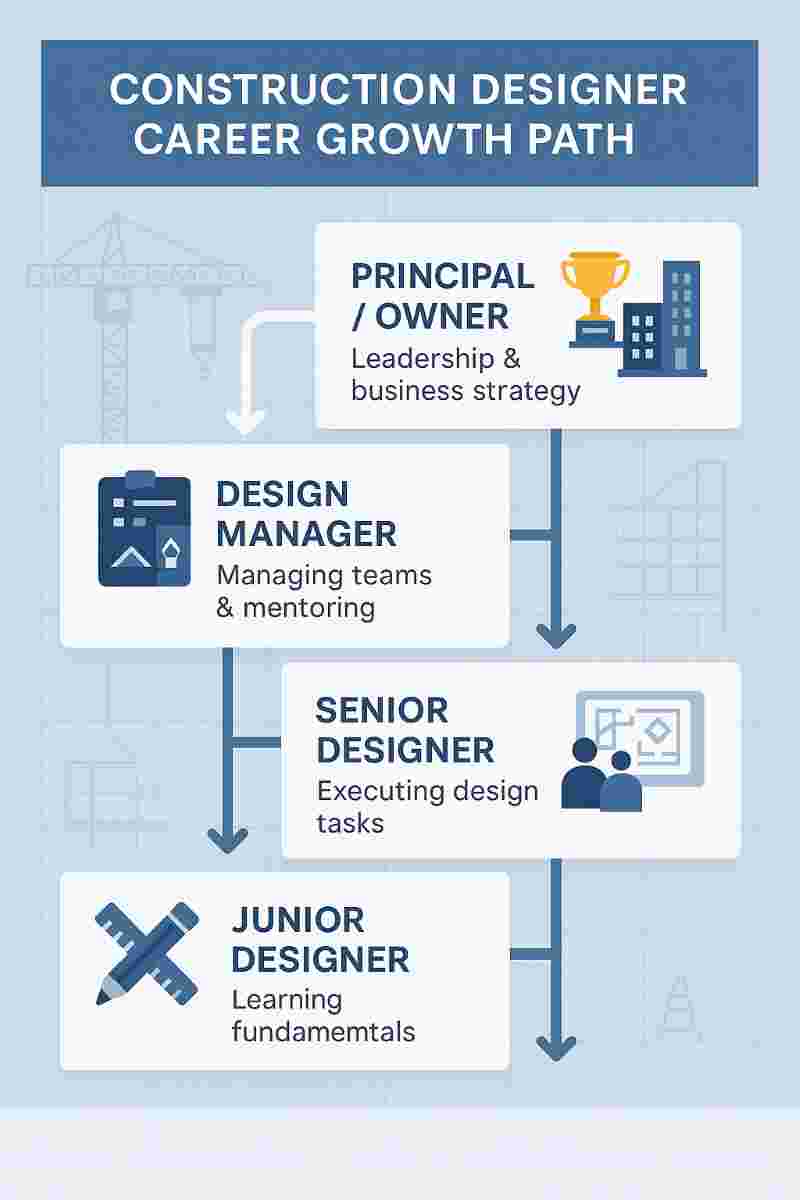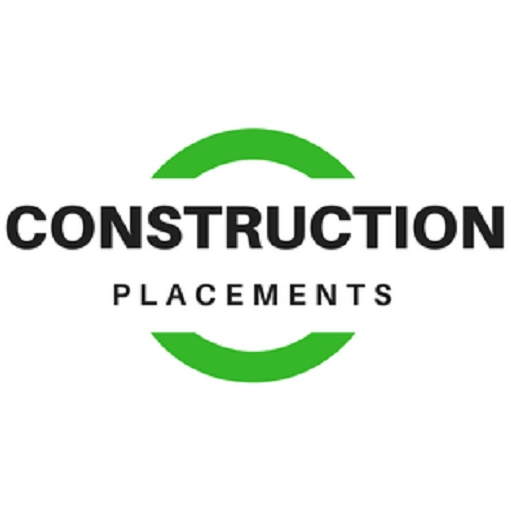Last Updated on October 4, 2025 by Admin
If you’ve ever looked at a house, school, or clinic under construction and wondered, “Who actually turns ideas into buildable plans?”—you’re thinking of a construction designer. These professionals bridge the gap between creative vision and structural reality, transforming client needs into detailed, code-compliant blueprints while earning $53,000 to $95,000+ annually, depending on experience and specialization.
In the United States, construction designers occupy a critical middle ground between drafters and licensed architects. They focus primarily on residential and light commercial projects, offering clients a more accessible and cost-effective alternative to full architectural services while maintaining professional standards through certifications like the Certified Professional Building Designer (CPBD).
Unlike architects who require extensive licensure and can design any structure, construction designers provide specialized expertise that’s perfectly suited for single-family homes, small office buildings, retail spaces, and renovation projects.
The role combines CAD/BIM software mastery with building code expertise and client collaboration, positioning professionals as essential contributors throughout the entire construction process—from initial site assessment and programming through final inspections and project closeout.
🚀 Improve Your Interview Skills with the Construction Interview Coach
Practice 15+ AI-generated technical and HR interview questions for Civil, BIM, QS, Planning, HSE and Construction roles. Get instant feedback, improved answers, a 7-day improvement plan, and a full PDF report. Designed exclusively for construction professionals.
One free full interview session included. No credit card required.
With the construction industry facing a 500,000+ worker shortage and federal infrastructure investments totaling $552.8 billion, demand for skilled construction designers continues to accelerate through 2034, particularly for those proficient in Building Information Modeling using Revit, sustainable design practices, and digital collaboration platforms.
The profession appeals to career changers, recent graduates, and professionals seeking alternatives to traditional architecture paths.
This comprehensive guide breaks down what construction designers actually do in the United States, the skills you’ll need, current salary benchmarks with geographic variations, the education and certification pathways that lead to success, and how the role integrates into modern project delivery methods like design-build.
TL;DR (Key Takeaways for Busy Readers)
- Construction designers plan and coordinate building design, translating client needs into buildable drawings and models while coordinating with architects, engineers, and contractors throughout project phases
- The role overlaps with titles like Architectural Designer, Building Designer, Design Engineer, or Design Manager, depending on project type and state regulations
- Median US salaries (May 2024 BLS): Architects $96,690, Civil Engineers $99,590, Drafters $65,380; Construction Managers $104,900 (useful benchmark for design managers)
- Job outlook (2024–2034): Architects +4%, Civil Engineers +5%, Drafters ~0% (stable)
- For small residential projects, Building Designers (CPBD-certified) may lead design; larger/complex projects typically require licensed architects
- You can design a building online for free with SketchUp for Web, FreeCAD, Blender, and try education access for Autodesk Revit if eligible
What Construction Designers Actually Do: The Complete Role Definition
In US practice, “construction designer” is an umbrella term that encompasses several specialized roles:
- Architectural Designer: Often, early-career architects work under a licensed architect’s supervision
- Building Designer: Commonly focuses on residential/light-commercial projects; many pursue CPBD certification through NCBDC/AIBD
- Design Engineer: Civil, structural, or MEP specialists focusing on technical systems
- Design/Preconstruction Manager: Coordinates scope, cost, schedule, and constructability analysis
The core function: You’re the hub connecting client goals, building codes, engineering requirements, budget constraints, and constructability—from early sketches through construction documents and on-site support during building.
Where Construction Designers Fit: The Six Design Phases
US construction projects flow through AIA-recognized design phases, and construction designers play critical roles in each:
1. Programming/Pre-Design: Establishing space needs, budget parameters, site analysis, and code research to create the project foundation.
2. Schematic Design (SD:) Developing big-picture layouts, building massing, preliminary systems, and initial cost estimates at 15-20% design completion.
3. Design Development (DD) Refining systems, selecting materials, coordinating disciplines, and updating estimates at 50-60% completion.
4. Construction Documents (CD) Creating detailed permit-ready and bid-ready drawings/specifications that fully define design intent at 95-100% completion.
5. Bidding/Negotiation Issuing documents for contractor pricing, answering pre-bid questions, and evaluating proposals.
6. Construction Administration (CA) Supporting construction with RFI responses, submittal reviews, site visits, and punch list coordination.
Day-to-Day Responsibilities
Construction designers develop building plans and specifications for residential homes, small commercial structures, and light industrial facilities. The American Institute of Building Design defines them as professionals “familiar with all facets of the building trade, whose plans and designs represent the particular needs, style, and budget of the client.”
Daily tasks center on creating design concepts that balance practical functionality with aesthetic appeal and economic feasibility:
- Client discovery & programming: Translate needs into design briefs and budget envelopes
- Concept & schematic design: Test layouts/massing while reviewing zoning setbacks and height limits
- Coordination: Work with structural/MEP/civil teams during Design Development
- Documentation: Create/organize Construction Documents for permits and contractor pricing
- Permit support: Ensure compliance with IBC 2024 codes as adopted locally
- Construction phase support: Answer RFIs, review submittals, and conduct site observations
- Design-Build collaboration: Partner with contractors from day one for accelerated delivery
Construction designers occupy a critical position in the design-build workflow, typically serving as the first professional involved during pre-design and planning phases.
They conduct site surveys and feasibility studies before developing schematic designs with preliminary drawings and 3D renderings. During design development, they finalize specifications and refine cost estimates, then produce complete construction document sets for permit submission and contractor bidding. Throughout construction administration, designers verify that work aligns with approved plans and resolve issues that emerge during building.
This continuous involvement from concept to completion distinguishes them from drafters who merely document designs created by others, and from architects who may hand off projects after permitting on traditional design-bid-build contracts.
Construction Designer vs. Architect vs. Engineer: Critical Differences
Understanding these distinctions helps clarify career pathways and project scope limitations:
Construction Designers vs. Architects
Architects require 5-7 years of formal education through NAAB-accredited bachelor’s or master’s programs, must complete 3,740 hours of supervised training through the AXP program, pass the rigorous Architect Registration Examination (ARE), and obtain state licensure.
The protected “architect” title carries legal authority to stamp construction documents for any building type, from single-family homes to high-rise towers, with full liability for structural safety. Average architect salary: $96,690 annually (May 2024 BLS).
Construction designers face no mandatory licensure in most US states and may enter with associate degrees or technical diplomas, though bachelor’s degrees are increasingly common.
Their scope primarily encompasses residential and small commercial projects, with size/complexity restrictions varying by jurisdiction. While they cannot use the “architect” title or independently approve large structures, construction designers offer clients more affordable options for appropriate projects. Average salary: $53,000-$71,000 annually.
If your goal is to stamp drawings as the professional of record, you must follow the architect licensure path or the engineering licensure. For residential projects, a CPBD building designer can be ideal and cost-effective—always check your local regulations.
Construction Designers vs. Engineers
Civil Engineers concentrate on infrastructure—roads, bridges, water systems, site grading, and drainage—requiring ABET-accredited bachelor’s degrees and Professional Engineer (PE) licensure for public projects. Their work involves structural calculations, soil mechanics, and surveying. Median earnings: $99,590 (May 2024 BLS).
Structural Engineers specialize in load-bearing design and structural integrity, ensuring buildings withstand environmental forces through advanced mathematical analysis. On projects requiring both disciplines, civil engineers handle site conditions while construction designers focus on the building itself.
Construction Designers vs. Draftsmen
Draftsmen/CAD Technicians convert designs created by architects or engineers into technical drawings, working under supervision with limited design authority. They need CAD proficiency but minimal building systems knowledge. Median salary: $65,380.
Construction Designers create original designs from scratch, make independent decisions about materials and layouts, understand mechanical/electrical systems comprehensively, and require minimal supervision. Career progression often flows: Drafter → CAD Designer → Construction/Building Designer. The CPBD certification formalizes this advancement.

Essential Skills & Tools Construction Designers Need
Core Technical Capabilities
Software Proficiency (The Foundation)
AutoCAD and Revit represent the two most critical platforms. AutoCAD remains the industry standard for 2D drafting and 3D design, used to create construction drawings, floor plans, and technical documentation. Revit has emerged as the leading Building Information Modeling platform, integrating 3D modeling with construction documentation and enabling multidisciplinary coordination across architectural, structural, and MEP systems.
Beyond these core tools, construction designers increasingly need:
- BIM Coordination: Autodesk Navisworks for clash detection, BIM Collaborate for cloud-based team coordination
- 3D Modeling: SketchUp for conceptual design, ArchiCAD or Bentley Systems as Revit alternatives
- Visualization: Lumion, Twinmotion, or Blender for photorealistic renders and animations
- Field Apps: Autodesk Construction Cloud mobile for markups, issues, and forms
Building Science Knowledge
- Space planning and code compliance (IBC 2024 awareness)
- Building envelope and waterproofing fundamentals
- Construction means, methods, and cost awareness
- MEP systems understanding for coordination
- Structural design principles for feasibility checks
Free & Low-Cost Software to Design Buildings Online
SketchUp for Web (Free) Browser-based 3D modeling with Trimble Connect and 3D Warehouse access—perfect for conceptual design and client presentations.
FreeCAD Open-source parametric CAD/BIM with add-ons for precision work and technical documentation.
Blender (Free): Powerful for concept modeling, rendering, and animation—creates stunning visuals that impress clients.
Autodesk Revit (Education Access) Free for eligible students/educators, renewable annually—the industry standard for BIM.
Pro Tip: Start sketches in SketchUp/FreeCAD → move to Revit (if available) for BIM documentation → render in Blender for presentations. This practical workflow works well for early-career designers building portfolios.
Critical Soft Skills
Research shows these foundational capabilities accelerate learning, lead to higher earnings, and provide resilience as AI transforms the industry:
- Communication: Present design concepts clearly to non-technical clients
- Collaboration: Coordinate across architects, engineers, and contractors
- Project Management: Deliver within budget and schedule constraints
- Problem-Solving: Address design challenges and construction issues
- Attention to Detail: Ensure accurate specifications and code compliance
- Adaptability: Continuously learn new technologies and methods
For comprehensive skill development guidance, explore our Essential Construction Skills for Job Seekers guide.
Education Pathways & Professional Certifications
Degree Routes (What Employers Expect)
Bachelor’s Degree (4-5 Years) — The Standard Path
Four-year programs in construction management, architectural design, civil engineering, or construction science provide comprehensive preparation, including building materials, construction methods, structural principles, codes, project management, and CAD/BIM software. Top programs include:
- Purdue University’s Design and Construction Integration (800-hour internship requirements)
- Texas A&M Construction Science (nation’s largest program)
- Auburn University College of Architecture, Design and Construction
- Virginia Tech and University of Florida programs
Cost: $40,000-$120,000 total | Starting salary: $65,000-$75,000
Associate Degree (2 Years) — Faster, Affordable Entry
Two-year programs in architectural design, building design, or construction technology at community colleges like St. Petersburg College and Florida SouthWestern State College offer technical training in Revit, CAD, and sustainable construction.
Cost: $10,000-$30,000 total | Starting salary: $40,000-$55,000 as drafter/assistant designer
Architecture Track
For those pursuing licensure: NAAB-accredited B.Arch or M.Arch → AXP (3,740 hours) → ARE exams → State licensure through NCARB.
Online & Alternative Paths
- Online construction management degrees from Louisiana State University, Arkansas State University, University of Oklahoma
- Apprenticeships with licensed architects or construction firms (3-6 years)
- Experience-based pathway to CPBD (six years of professional work)
Explore career pathway resources: Introduction to Construction Careers | Master Construction Job Hunting Guide
Certifications That Make a Difference
Certified Professional Building Designer (CPBD) The gold standard for residential/light commercial designers. Requirements: Four-year degree + 3 years experience, OR six years professional experience + passing 175-question exam. Annual renewal: $150 + 8 CEUs.
Autodesk Certified Professional – Revit Validates advanced Revit skills for architectural design—highly valued by employers practicing BIM workflows.
LEED Green Associate Entry-level sustainability credential showing foundational green building knowledge. Pathway to LEED AP specialties for advanced sustainable design.
Certified Construction Manager (CCM): The gold standard for management roles, associated with 10% higher salaries. Requires: Bachelor’s degree + 4 years of construction management experience.
OSHA 10/30-Hour Construction Safety training that improves field credibility and site access—widely recognized across US jobsites.
For interview preparation: Top 50 Civil BIM Designer Interview Questions | Top 50 Revit Interview Questions
Current US salary data & compensation factors (trimmed)
Benchmarks (May 2024–2025 ranges)
BLS proxy (Architectural/Civil Drafters, SOC 17-3011): median $65,380; middle 50% $49,660–$77,020.
Market sources (role/title mixes):
- PayScale: ~$53k avg (≈ $39k–$74k + bonuses).
- Salary.com: ~$71k avg (≈ $56.7k–$85k).
- Indeed/Glassdoor (architectural designer comps): ~$75k–$85k avg.
- ZipRecruiter (broad “construction design”): ~$49k entry → ~$95k senior.
Variation reflects title scope (designer vs drafter), seniority, specialization, and credentials.
By experience (typical ranges)
- Entry (0–1 yr): $40k–$55k (drafter/assistant designer).
- Mid (3–7 yrs): $60k–$85k (lead packages, client-facing).
- Senior (8–15 yrs): $85k–$120k+ (multi-project leadership).
- Veteran/Owner (15–20+ yrs / CPBD / firm principal): $120k–$140k+.
Location effects
- High-paying states/metros (means often $75k–$90k+): AK, DC, CA; San Jose, San Francisco, NYC.
- Purchasing power can favor Midwest markets (IL, MN, WI, OH).
- Biggest job counts: TX, CA, FL, NY, PA (not always highest pay).
Role comparisons (medians/typicals)
- Construction Manager: ~$105k+
- Civil Engineer: ~$100k
- Architect: ~$97k
- Building/Construction Designer (blended sources): ~$53k–$71k avg; seniors higher
- CAD Technician / Drafter: ~$65k median
What moves pay (beyond experience & geography)
- Sector: Nonresidential GC & specialty contractors tend to pay more than small design shops.
- Firm size: Large firms often +20–25% vs. small practices (–15–20%).
- Education: HS/Cert start ~$54k–$58k; Bachelor’s ~$65k–$75k.
- Credentials: CPBD, LEED, Autodesk (Revit) can add ~10–20%.
- Stacked skills: BIM/VDC, energy modeling, healthcare/data-center experience, and client management lift ceilings.
Career advancement & market outlook (trimmed)
Common pathways
- Degree route: BS in Construction Mgmt/Architecture/Civil → internships → BIM-heavy roles → lead designer/PM.
- Experience + certification: Community college/associate → drafter → CPBD (experience pathway) → independent designer.
- Upskill online: Accredited online CM/Design programs + Revit/LEED/OSHA credentials while working.
Progression
-
Junior → Designer/Lead (own DD/CD sets, client consults) → Senior/Director (portfolio oversight, QA, clients) → Principal/Owner or pivot to CM/AE management.
Outlook (through 2034)
- Rising demand for BIM/VDC designers despite flat traditional drafting.
- Growth drivers: IIJA/CHIPS/IRA funding, housing shortage, sustainability retrofits, and aging infrastructure.
- Talent shortage sustains leverage on pay, hybrid work, and project choice.
Remote/hybrid
-
Most common for BIM/CAD, VDC, schedulers, estimators; hybrid preferred for field-coordination roles.
Skills in highest demand
- Revit-first BIM, coordination (Navisworks/BIM Collab), code literacy (IBC + local), MEP/structural awareness, cost/schedule basics, LEED/energy modeling, and client communication.
- Emerging: AI-assisted design, digital twins, AR/VR, industrialized/modular design.
Bottom line: Aim for BIM mastery + a visible specialty (healthcare, data centers, high-performance homes), layer credentials (CPBD/LEED/Autodesk), and cultivate client-facing skills—the fastest route to top-tier compensation.
A practical profession for the digital construction era
Construction design is a pragmatic, high-impact career for people who love building design without pursuing full architectural licensure. It thrives in residential and light commercial work—delivering technical value at accessible fees—while offering solid middle- to upper-middle-class earnings. As routine drafting automates, demand is rising for designers who pair design judgment with BIM-first workflows, collaboration, and building-science literacy.
3 forces shaping the role through 2030
- BIM as baseline: Revit + parametric tools (e.g., Dynamo/Grasshopper), AI-assisted modeling, and digital twins are becoming standard. Continuous upskilling beats legacy CAD.
- Talent squeeze: Labor shortages + infrastructure spending = leverage on pay, flexibility, and project choice for skilled designers.
- Sustainability edge: Federal funding and corporate ESG keep green building in focus; LEED/energy modeling/materials know-how differentiates you.
Fast paths by profile
- Students: Earn a relevant bachelor’s (e.g., construction mgmt), stack BIM certifications, pursue internships, target firms using IPD/advanced BIM.
- Career changers: Combine online degree completion with CPBD prep; leverage the experience pathway to certification while working.
- Practicing designers: Add advanced software certs, PM credentials (PMI-CP/CCM), and specialize in healthcare, data centers, or high-performance homes.
Bottom line: The winners are designers who keep learning tech, and sharpen client communication, coordination, and problem-solving—the human skills software can’t replace.
Related Posts:
- Most Essential AutoCAD Shortcut Keys | AutoCAD Commands List
- A Comprehensive Guide to Becoming a BIM Designer
- How Civil Engineers Can Thrive in the Age of AI and AGI?: A Detailed Report
- Exploring Careers in Architecture and Construction Design


